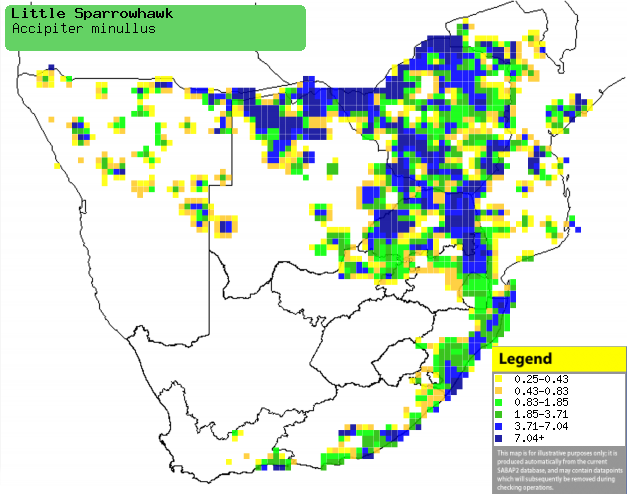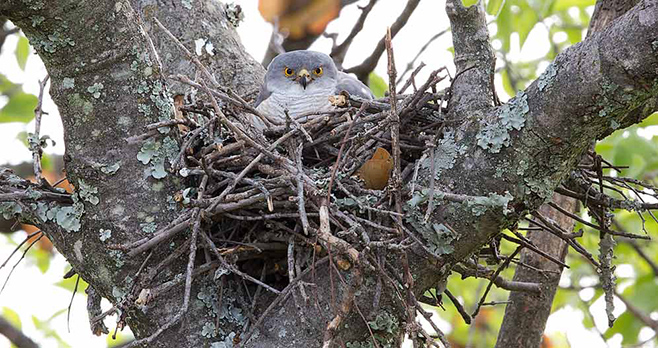|
Accipiter minullus (Little
sparrowhawk)
Kleinsperwer [Afrikaans]; Ukhetshana (also applied to
Rufous-chested sparrowhawk) [Xhosa]; uMqwayini [Zulu]; Kakodi (generic
term for sparrowhawks, goshawks, kestrels and falcons) [Kwangali]; Rukodzi
(generic name for a small raptor such as falcon or sparrowhawk) [Shona];
Oostafrikaanse dwergsperwer [Dutch]; Épervier minule [French];
Zwergsperber [German]; Gavião-pequeno [Portuguese]
Life
> Eukaryotes >
Opisthokonta
> Metazoa (animals) >
Bilateria >
Deuterostomia > Chordata >
Craniata > Vertebrata (vertebrates) > Gnathostomata (jawed
vertebrates) > Teleostomi (teleost fish) > Osteichthyes (bony fish) > Class:
Sarcopterygii (lobe-finned
fish) > Stegocephalia (terrestrial
vertebrates) > Tetrapoda
(four-legged vertebrates) > Reptiliomorpha > Amniota >
Reptilia (reptiles) >
Romeriida > Diapsida > Archosauromorpha > Archosauria >
Dinosauria
(dinosaurs) > Saurischia > Theropoda (bipedal predatory dinosaurs) >
Coelurosauria > Maniraptora > Aves
(birds) > Order: Falconiformes
> Family: Accipitridae
> Genus: Accipiter
Distribution and habitat
Occurs from Ethiopia, Uganda and Kenya south through
Tanzania, southern DRC, Angola and Zambia to South Africa. Here it is scarce to
uncommon in the northern half of Namibia. northern and south-eastern Botswana,
Zimbabwe, Mozambique and South Africa. It generally favours tall, dense woodland, forest
edges and stands of alien trees in otherwise open habitat (such as fynbos and
grassland); it may also move into suburban areas.
|
 |
|
Distribution of Little sparrowhawk in southern Africa,
based on statistical smoothing of the records from first SA Bird Atlas
Project (©
Animal Demography unit, University of
Cape Town; smoothing by Birgit Erni and Francesca Little). Colours range
from dark blue (most common) through to yellow (least common).
See here for the latest distribution
from the SABAP2. |
Predators and parasites
Adults have been recorded as prey of Melierax gabar (Gabar
goshawk), while nestlings are sometimes eaten by
Kaupifalco monogrammicus
(Lizard buzzard).
Movements and migrations
Resident and sedentary, although it may
disperse after the breeding season.
Food
It almost exclusively eats small birds, doing most of its
hunting from a perch concealed by dense foliage, swiftly ambushing and killing
its prey. The following food items have been recorded
in its diet:
- Vertebrates
- birds
- mammals
- lizards
- frogs
- Invertebrates
Breeding
|
 |
|
Little sparrowhawk female brooding young, Modimolle, Limpopo, South
Africa. [photo Warwick Tarboton ©] |
- Monogamous, territorial solitary nester, with the male performing a
display in which he perches with his body held horizontally, before swaying his
head from side to side.
- The nest is mainly built by the female, consisting of a small stick
platform thinly lined with green leaves. It is typically placed in the main
fork of a tree (especially alien species), although it may also use the old
nest of a Shikra or
Gabar goshawk instead of building its own.
It has been recorded to use the following trees for nesting:
- alien trees
- Eucalyptus
- Populus (poplars)
- Jacaranda acutifolia (Jacaranda)
- Salix babylonica (Weeping willow)
- indigenous trees
- Acacia
- A. nigrescens (Knob thorn)
- A. ataxacantha (Flame thorn)
- A. robusta (River thorn)
- Faidherbia albida (Ana tree)
- Kirkia acumenata (White kirkia)
- Sclerocarya birrea (Marula)
- Commiphora (corkwood)
- Ekebergia (ash)
- Brachystegia glaucescens (Mountain-acacia)
- Euphorbia
- Egg-laying season is from September-December, peaking during October.
- It lays 1-3 eggs, which are incubated by both sexes for about 31-32
days, although the female tends to do 75-80% of the incubation; the male
helps by feeding her regularly at the nest.
- The chicks are brooded by the female for most of the nestling period,
while the male gives her food to give to them. Any other birds who wander in
the vicinity of the nest are vigorously chased away, especially if the
intruder as another raptor. The chicks leave the nest at about 25-27 days
old, dispersing from their parents' territory up to a year later.
Threats
Not threatened.
References
-
Hockey PAR, Dean WRJ and Ryan PG 2005. Roberts
- Birds of southern Africa, VIIth ed. The Trustees of the John Voelcker
Bird Book Fund, Cape Town.
|
